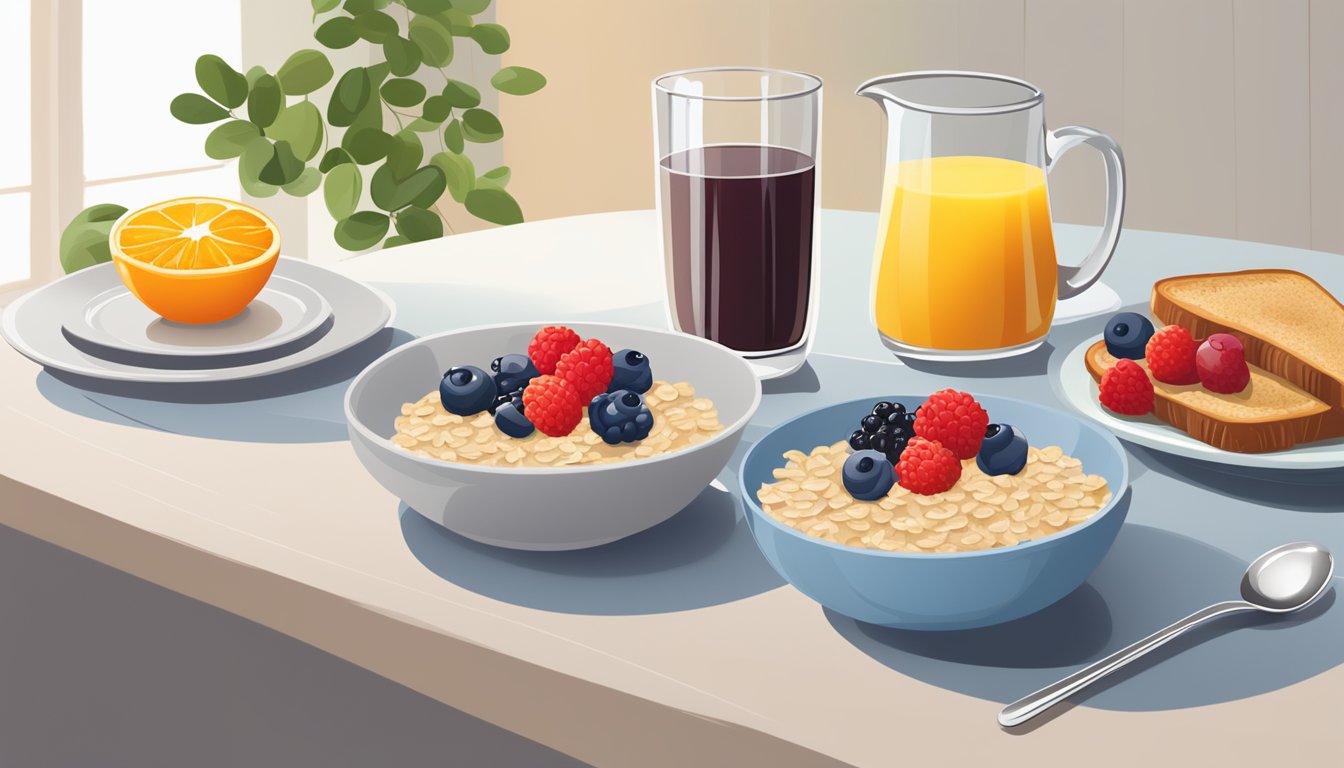Breakfast is the perfect opportunity to boost your daily fiber intake. Many delicious morning foods are naturally rich in this essential nutrient. Whole grains, fruits, vegetables, nuts, and seeds are excellent sources of dietary fiber that can easily be incorporated into your breakfast routine.
Starting your day with a fiber-filled meal offers numerous health benefits. It aids digestion, promotes gut health, and helps maintain stable blood sugar levels. High-fiber breakfasts also keep you feeling fuller for longer, which can support weight management efforts.
Oatmeal, whole grain toast, berries, chia seeds, and avocados are just a few fiber-packed options to consider for your morning meal. By choosing these nutrient-dense foods, you’ll be taking a significant step towards meeting your daily fiber requirements and supporting overall health.
Understanding Dietary Fiber
Dietary fiber plays a crucial role in maintaining digestive health and overall well-being. It comes in two main types and offers numerous benefits when consumed regularly, especially during breakfast.
Types of Fiber: Soluble and Insoluble
Soluble fiber dissolves in water, forming a gel-like substance in the digestive tract. It helps lower cholesterol levels and regulate blood sugar. Foods high in soluble fiber include oats, barley, and fruits like apples and berries.
Insoluble fiber doesn’t dissolve in water. It adds bulk to stool, promoting regular bowel movements and preventing constipation. Whole grains, nuts, and vegetables are excellent sources of insoluble fiber.
Both types of fiber are essential for a balanced diet. Many fiber-rich foods contain a mix of soluble and insoluble fiber, providing diverse health benefits.
Benefits of Fiber in Breakfast Foods
Consuming fiber-rich foods for breakfast offers several advantages. It promotes feelings of fullness, which can aid in weight management. Fiber slows down digestion, helping to stabilize blood sugar levels throughout the morning.
High-fiber breakfasts support digestive health by promoting regular bowel movements. This can reduce the risk of digestive issues like constipation and diverticulitis.
Fiber-rich breakfast options often contain other essential nutrients. Whole grains provide B vitamins, while fruits and vegetables offer vitamins, minerals, and antioxidants.
Recommended Daily Fiber Intake
The Academy of Nutrition and Dietetics recommends a daily fiber intake of 25 grams for adult women and 38 grams for adult men. However, most Americans fall short of these targets.
Starting the day with a high-fiber breakfast can significantly contribute to meeting daily fiber goals. Aim for breakfast options that provide at least 5 grams of fiber per serving.
Gradually increase fiber intake to allow the digestive system to adjust. Drink plenty of water when consuming more fiber to help it move through the digestive tract smoothly.
High-Fiber Breakfast Options
Incorporating fiber-rich foods into breakfast can kickstart your day with improved digestion and sustained energy. A variety of whole grains, fruits, vegetables, and protein sources offer delicious ways to boost fiber intake in the morning.
Whole Grains as a Fiber Source
Oatmeal stands out as a fiber powerhouse, providing 4 grams of fiber per cup. Steel-cut oats offer even more fiber and a chewier texture. Quinoa, though less traditional, packs 5 grams of fiber per cooked cup and adds protein.
High-fiber cereals, often made with bran or whole grains, can contain up to 14 grams of fiber per serving. Look for options with at least 5 grams of fiber per serving. Whole grain bread toasted and topped with nut butter adds 2-3 grams of fiber per slice.
Muesli, a mix of oats, nuts, and dried fruits, provides a crunchy alternative with 4-8 grams of fiber per serving. It can be enjoyed with milk or yogurt for added protein.
Incorporating Fruits and Vegetables
Berries rank high in fiber content among fruits. A cup of raspberries contains 8 grams of fiber, while strawberries and blueberries offer 3-4 grams per cup. Adding berries to cereal, oatmeal, or yogurt boosts flavor and nutrition.
Spinach and kale can be blended into smoothies or sautéed as a side dish, contributing 4-5 grams of fiber per cooked cup. Avocado toast has gained popularity, with half an avocado providing 5 grams of fiber.
Sweet potatoes, when baked and topped with Greek yogurt or cottage cheese, offer 3-4 grams of fiber. Broccoli can be incorporated into breakfast quiches or frittatas, adding 5 grams of fiber per cup.
Protein and Fiber Combination
Combining protein with fiber creates satisfying meals that promote fullness. Greek yogurt parfaits layered with granola and berries provide both protein and fiber. A breakfast salad with spinach, quinoa, and hard-boiled eggs offers a savory option.
Avocado toast on whole grain bread topped with smoked salmon or scrambled eggs combines healthy fats, protein, and fiber. Smoothie bowls made with high-fiber fruits, chia seeds, and protein powder offer a customizable meal.
Vegetable omelets filled with broccoli, spinach, and cheese provide protein while boosting fiber intake. For a grab-and-go option, whole grain wraps filled with scrambled eggs, vegetables, and beans offer a balanced meal.
Fiber-Enriched Recipes for Breakfast
Incorporating fiber-rich ingredients into breakfast dishes can be delicious and nutritious. These recipes offer creative ways to boost fiber intake while enjoying tasty morning meals.
Smoothie and Smoothie Bowl Creations
Smoothies and smoothie bowls provide an easy way to pack in fiber. Blend fruits like berries, banana, and mango with leafy greens such as spinach or kale. Add chia seeds, ground flaxseed, or hemp seeds for extra fiber and nutrients.
For a thicker smoothie bowl, use less liquid and top with sliced fruit, nuts, and granola. Try a green smoothie with spinach, banana, almond milk, and chia seeds. Or create a berry smoothie bowl with mixed berries, Greek yogurt, and a sprinkle of hemp seeds.
Omelet and Scrambles with a Fiber Twist
Eggs can be paired with fiber-rich vegetables and legumes for a satisfying breakfast. Add spinach, bell peppers, and mushrooms to omelets or scrambled eggs. Include black beans or white beans for additional fiber and protein.
Try a vegetable-packed omelet with spinach, tomatoes, and bell peppers. For a Mexican-inspired dish, make a bean and egg scramble with black beans, salsa, and avocado. Shakshuka, a dish of eggs poached in tomato sauce, can be served with whole grain bread for extra fiber.
Creative Takes on Porridge and Pancakes
Oatmeal and other whole grain porridges are excellent sources of fiber. Experiment with different grains like quinoa or buckwheat. Add nuts, seeds, and fruit for more fiber and flavor.
Make overnight oats with rolled oats, chia seeds, and almond milk. Top with berries and a dollop of nut butter. For a twist on pancakes, try buckwheat pancakes topped with sliced bananas and a drizzle of almond butter.
Chia pudding is another fiber-rich option. Mix chia seeds with milk or plant-based milk and let sit overnight. Add fruit and nuts before serving.
Nutrient-Packed Breakfast Wraps and Tacos
Whole grain tortillas can be filled with fiber-rich ingredients for a portable breakfast. Use scrambled eggs, beans, vegetables, and salsa for a savory option. For a sweeter version, spread nut butter and add sliced fruit.
Create a breakfast burrito with scrambled eggs, black beans, spinach, and salsa in a whole wheat tortilla. For breakfast tacos, fill corn tortillas with scrambled eggs, white beans, and avocado. Add a sprinkle of hemp seeds for extra nutrition.
Fiber Boosters to Add to Your Breakfast
Adding fiber-rich ingredients to your morning meal can significantly increase your daily fiber intake. These simple additions are easy to incorporate and pack a nutritional punch.
Seeds and Nuts for Extra Fiber
Chia seeds are a fiber powerhouse, providing about 10 grams per ounce. Sprinkle them on yogurt or oatmeal for a crunchy texture. Ground flaxseed offers a nutty flavor and about 8 grams of fiber per ounce. It blends well into smoothies or can be mixed into batter for pancakes or muffins.
Hemp seeds contain around 1 gram of fiber per tablespoon and are rich in omega-3 fatty acids. They’re great on top of avocado toast or mixed into granola.
Nuts like almonds and walnuts add fiber and healthy fats. A handful (about 1 ounce) provides 3-4 grams of fiber. Nut butters are convenient alternatives. Two tablespoons of almond or peanut butter contain 3-4 grams of fiber.
Legumes: A Powerhouse of Fiber and Protein
Beans are excellent sources of both fiber and protein. Half a cup of black beans offers about 8 grams of fiber, while white beans provide around 6 grams.
Try adding beans to breakfast burritos or scrambled eggs for a savory start to the day. Mash them and spread on toast for a quick, fiber-rich meal.
Hummus, made from chickpeas, is another versatile option. Use it as a spread on whole grain toast or as a dip for raw vegetables.
Lentils can be incorporated into breakfast bowls or mixed with grains for a hearty morning meal. One half-cup serving provides about 8 grams of fiber.
Fiber-Fortified Products
Many breakfast cereals are fortified with extra fiber. Look for options that provide at least 5 grams of fiber per serving. Some high-fiber cereals can offer up to 14 grams per cup.
Frozen waffles are now available in high-fiber varieties. These products often use whole grains and added fiber to boost their nutritional value. Check labels for options with at least 3 grams of fiber per serving.
Fiber-fortified yogurts and smoothies are also entering the market. These products typically include added inulin or chicory root fiber to increase their fiber content.
When choosing fortified products, pay attention to added sugars and artificial ingredients. Opt for options with minimal processing and whole food ingredients when possible.
Nutritional Considerations and Pairings
Maximizing the benefits of high-fiber breakfasts involves strategic nutrient combinations and adaptations for individual health goals. Proper pairings can enhance satiety, gut health, and overall nutritional intake.
Balancing Macronutrients for Satiety
Combining fiber-rich foods with protein and healthy fats creates a balanced breakfast that promotes fullness. Eggs paired with whole grain toast provide a mix of fiber and protein. Greek yogurt topped with berries and nuts offers fiber, protein, and healthy fats.
Adding cottage cheese to a fiber-rich breakfast boosts protein content. This combination helps stabilize blood sugar levels and reduces mid-morning hunger pangs.
Omega-3 fatty acids from sources like chia seeds or flaxseeds complement fiber-rich breakfasts. These healthy fats support brain health and reduce inflammation.
The Role of Probiotics and Prebiotics with Fiber
Pairing probiotic-rich foods with fiber creates a synergistic effect for gut health. Yogurt or kefir combined with high-fiber fruits or oats supports a healthy microbiota.
Prebiotic fibers, found in foods like bananas and oats, feed beneficial gut bacteria. Consuming these alongside probiotic foods enhances their effectiveness.
Fermented foods like kimchi or sauerkraut add both probiotics and fiber to breakfast. These can be incorporated into savory breakfast bowls or omelets.
Dietary Adaptations for Specific Health Goals
For weight management, focus on high-volume, low-calorie fiber sources like vegetables. Adding spinach or kale to smoothies increases fiber without significantly impacting calorie content.
Those aiming to lower cholesterol can emphasize soluble fiber from oats, apples, and flaxseeds. These foods help reduce LDL cholesterol levels when consumed regularly.
For blood sugar control, pairing fiber with protein is crucial. A breakfast of Greek yogurt with berries and nuts provides a balanced mix of nutrients to stabilize glucose levels.
Individuals with digestive issues may benefit from gentle fiber sources. Cooked fruits and vegetables are often easier to tolerate than raw varieties.
Additional Nutrients in High-Fiber Foods

High-fiber breakfast foods offer more than just digestive benefits. They provide a wealth of essential vitamins, minerals, and antioxidants that support overall health and wellbeing.
Vitamins and Minerals in Fiber-Rich Breakfasts
Fiber-rich breakfast options are often nutrient powerhouses. Whole grains contain B vitamins, iron, and magnesium. Oats provide manganese, phosphorus, and zinc. Fruits like raspberries, blueberries, and blackberries are excellent sources of vitamin C and potassium.
Avocados offer vitamin K, folate, and healthy fats. Bananas provide vitamin B6 and potassium. Dried fruits are concentrated sources of various minerals. Nuts and seeds in granola or as toppings contribute vitamin E, selenium, and magnesium.
A high-fiber breakfast incorporating these foods can significantly boost daily nutrient intake.
Beyond Fiber: Identifying Antioxidant Sources
Many high-fiber breakfast foods are also rich in antioxidants. Berries are antioxidant superstars, with blueberries, blackberries, and raspberries topping the list. These fruits contain anthocyanins and other polyphenols that help protect cells from damage.
Pears and apples provide quercetin, a powerful antioxidant. Nuts and seeds contribute vitamin E and selenium, both potent antioxidants. Whole grains contain lignans and phenolic acids with antioxidant properties.
Dried fruits like raisins, prunes, and goji berries are concentrated sources of various antioxidants. Including a variety of these foods in breakfast can boost antioxidant intake and support long-term health.




